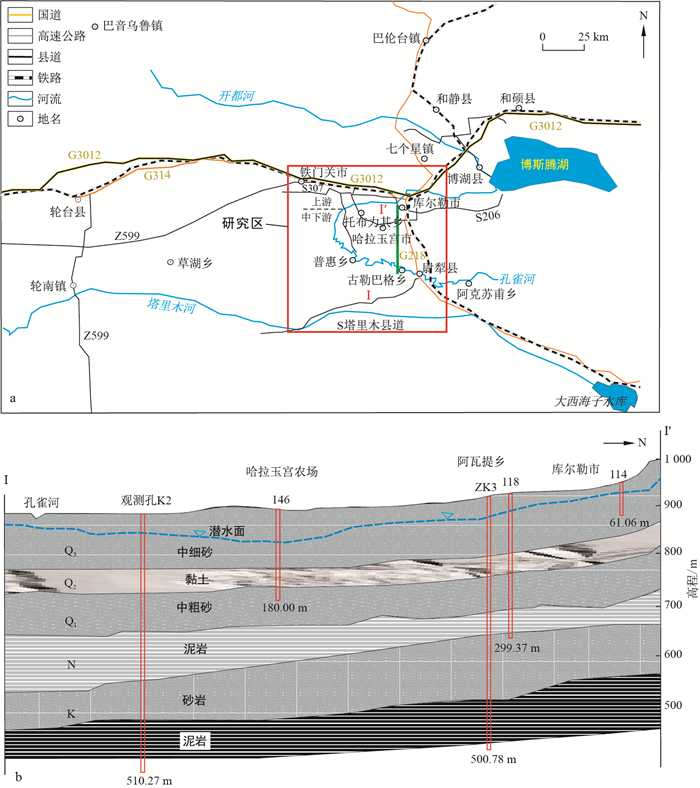Evolution characteristics of groundwater flow systems in the past 50 years in Kongqi River irrigation district, Xinjiang, China
-
摘要: 新疆孔雀河灌区面临地下水超采问题,科学认识区域地下水流系统的发育条件和演变特征,是优化地下水资源开发利用方式的基础。通过构建第四系含水层三维地下水稳定流模型,利用流线追踪技术,模拟识别了孔雀河流域1970-2020年期间地下水流系统的变化特征。结果表明,不同补给区和排泄区通过流线进行组合,在孔雀河周边形成了交错分布的地下水流系统,其空间分布格局随灌区地下水开采规模而变化。在20世纪70年代的拟天然状态,灌区主要发育自北向南的地下水流系统,其空间分布格局取决于水文地质参数和排泄要素,并可能存在1~4个以孔雀河为排泄带的流动系统。在有强烈地下水开采的现状条件下,灌区地下水流系统转变为从四周流向漏斗中心,截断了从孔雀河上游渗漏到中下游河道排泄的水流系统。近50 a来,以潜水蒸发为排泄方式的地下水流系统投影面积萎缩了29%,而以地下水开采为排泄方式的地下水流系统投影面积从零增加到研究区面积的40%。潜水蒸发对自然生态系统具有重要的支撑作用,灌区地下水开采应有所控制以保障潜水蒸发型地下水流系统的发育条件。Abstract: The Kongqi River Irrigation District (KRID) in Xinjiang, China, has a serious problem of groundwater overexploitation.A scientific understanding of the development conditions and evolution characteristics of regional groundwater flow systems is the basis for optimizing the utilization of groundwater resources.The variation characteristics of groundwater flow systems in KRID, from 1970 to 2020, were simulated and identified via numerical modeling and streamlines tracing of the three-dimensional steady-state groundwater flow in the Quaternary aquifers.As indicated, a complex patterns of groundwater flow systems can be developed around the Kongqi River, with streamlines linking different recharge and discharge zones, varying with the pumping intensity of groundwater in KRID.In the 1970s when the condition was close to a natural state, groundwater flow systems with north-to-south flow dominated the irrigation district, and the spatial pattern depended on hydrogeological parameters and recharge-discharge factors.There were possibly 1-4 flow systems discharge to the Kongqi River in the natural condition.Currently, groundwater is strongly exploited in the irrigation district, and groundwater flow systems are attracted by the groundwater withdrawal funnel with recharge from surrounding areas, cutting off the groundwater flow system with recharge from the leaking upper reaches of the Kongqi River and discharge into the middle-lower reaches.In the past 50 years, the projected area for groundwater flow systems of the phreatic evaporation discharge has decreased by 29%, while the projected area for groundwater flow systems of pumping discharge has increased from zero to 40% of the total model area.Phreatic evaporation plays an important role in supporting natural ecosystems.Therefore, groundwater exploitation should be controlled in the irrigation district, to maintain the development condition for groundwater flow systems of phreatic evaporation discharge.
-
表 1 模型校正后水平渗透系数的分区值
Table 1. Best fitting values of horizontally hydraulic conductivity in each zone
K/(m·d-1) 分区编号 1 2 3 4 5 6 7 8 9 潜水含水层 50 50 40 30 30 20 10 2 2 弱透水层 10 5 5 2 1 0.5 — — — 承压含水层 20 20 20 25 10 40 20 5 — 表 2 不同补给区和排泄区配对可能形成的地下水流系统编码
Table 2. Code number of groundwater flow systems with possible linking of different recharge and discharge zones
排泄类型 编号 侧向径流补给 河道渗漏补给 灌溉入渗补给 降水入渗补给 北侧边界 西侧边界 东北边界 孔雀河上游 孔雀河中下游 塔里木河 1 2 3 4 5 6 7 8 孔雀河中下游溢出排泄 1 S11 S21 S31 S41 / / / / 潜水蒸发排泄 2 S12 S22 S32 S42 S52 S62 S72 S82 东边界侧向径流排泄 3 / S23 S33 / S53 S63 S73 / 地下水开采排泄 4 S14 S24 S34 S44 S54 / S74 / -
[1] Tóth J. A theory of groundwater motion in small basins in central Alberta, Canada[J]. Journal of Geophysical Research, 1962, 67: 4375-4387. doi: 10.1029/JZ067i011p04375 [2] Tóth J. A theoretical analysis of groundwater flow in small drainage basins[J]. Journal of Geophysical Research, 1963, 68: 4795-4812. doi: 10.1029/JZ068i016p04795 [3] 梁杏, 张人权, 靳孟贵. 地下水流系统: 理论、应用、调查[M]. 北京: 地质出版社, 2015.Liang X, Zhang R Q, Jin M G. Groundwater flow systems: Theory, application and investigation[M]. Beijing: Geological Publishing House, 2015(in Chinese). [4] 蒋小伟, 万力, 王旭升. 区域地下水流理论进展[M]. 北京: 地质出版社, 2013.Jiang X W, Wan L, Wang X S. Advance in thetheory of regional groundwater flow[M]. Beijing: Geological Publishing House, 2013(in Chinese). [5] Wang J Z, Wörman A, Bresciani E, et al. On the use of late-time peaks of residence time distributions for the characterization of hierarchically nested groundwater flow systems[J]. Journal of Hydrology, 2016, 543: 47-58. doi: 10.1016/j.jhydrol.2016.04.034 [6] 梁杏, 张人权, 牛宏, 等. 地下水流系统理论与研究方法的发展[J]. 地质科技情报, 2012, 31(5): 143-151. https://www.cnki.com.cn/Article/CJFDTOTAL-DZKQ201205020.htmLiang X, Zhang R Q, Niu H, et al. Development of the theory and research method of groundwater flow system[J]. Geological Science and Technology Information, 2012, 31(5): 143-151(in Chinese with English abstract). https://www.cnki.com.cn/Article/CJFDTOTAL-DZKQ201205020.htm [7] Han P F, Wang X S, Wan L, et al. The exact groundwater divide on water table between two rivers: A fundamental model investigation[J]. Water, 2019, 11: 1-11. [8] Liang X, Liu Y, Jin M, et al. Direct observation of complex Tóthian groundwater flow systems in the laboratory[J]. Hydrological Processes, 2010, 24(24): 3568-3573. doi: 10.1002/hyp.7758 [9] Wang X S, Jiang X W, Wan L, et al. A new analytical solution of topography-driven flow in a drainage basin with depth-dependent anisotropy of permeability[J]. Water Resources Research, 2011, 47(9): 3101-3106. [10] Wang X S, Wan L, Jiang X W, et al. Identifying three-dimensional nested groundwater flow systems in a Tóthian basin[J]. Advances in Water Resources, 2017, 108. https://doi.org/10.1016/j.advwatres,2017,7:16. [11] Jiang X W, Wang X S, Wan L, et al. An analytical study on stagnant points in nested flow systems in basins with depth-decaying hydraulic conductivity[J]. Water Resources Research, 2011, 47(1), 128-139. [12] 梁杏, 张婧玮, 蓝坤, 等. 江汉平原地下水化学特征及水流系统分析[J]. 地质科技通报, 2020, 39(1): 21-33. doi: 10.19509/j.cnki.dzkq.2020.0103Liang X, Zhang J W, Lan K, et al. Hydrochemical characteristics of groundwater and analysis of groundwater flow systems in Jianghan Plain[J]. Bulletin of Geological Science and Technology, 2020, 39(1): 21-33(in Chinese with English abstract). doi: 10.19509/j.cnki.dzkq.2020.0103 [13] 江欣悦, 李静, 郭林, 等. 豫北平原浅层地下水化学特征与成因机制[J]. 地质科技通报, 2021, 40(5): 290-300. doi: 10.19509/j.cnki.dzkq.2021.0511Jiang X Y, Li J, Guo L, et al. Chemical characteristics and formation mechanism of shallow groundwater in the northern Henan Plain[J]. Bulletin of Geological Science and Technology, 2021, 40(5): 290-300(in Chinese with English abstract). doi: 10.19509/j.cnki.dzkq.2021.0511 [14] 陈亚宁. 新疆塔里木河流域生态保护与可持续管理[M]. 北京: 科学出版社, 2015.Chen Y N. Ecological protection and sustainable management of the Tarim River basin[M]. Beijing: Science Press, 2015(in Chinese). [15] 樊自立, 马映军. 干旱区水资源开发及合理利用的几个问题[J]. 干旱区研究, 2000, 17(3): 6-11. https://www.cnki.com.cn/Article/CJFDTOTAL-GHQJ200003001.htmFan Z L, Ma Y J. Some issues about the exploitation and the rational utilization of water resources in the arid areas[J]. Arid Zone Research, 2000, 17(3): 6-11(in Chinese with English abstract). https://www.cnki.com.cn/Article/CJFDTOTAL-GHQJ200003001.htm [16] 张国飞. 基于GMS的河谷冲淤积平原区地下水数值模拟研究[D]. 呼和浩特: 内蒙古农业大学, 2011.Zhang G F. Numerical simulation based on groundwater modeling system on alluvial and silted valley plain[D]. Huhhot: Inner Mongolia Agricultural University, 2011(in Chinese with English abstract). [17] 新疆库尔勒地质环境监测站. 新疆库尔勒市地下水动态监测五年报告(1996-2000年)[R]. 新疆库尔勒: 新疆库尔勒地质环境监测站, 2001.Geological Environment Monitoring Station in Korla, Xinjiang. Five-year report (1996-2000) on groundwater dynamic monitoring in Korla, Xinjiang[R]. Korla, Xinjiang: Geological Environment Monitoring Station in Korla, Xinjiang, 2001(in Chinese). [18] 新疆库尔勒地质环境监测站. 新疆库尔勒市地下水动态监测五年报告(2006-2010年)[R]. 新疆库尔勒: 新疆库尔勒地质环境监测站, 2011.Geological Environment Monitoring Station in Korla, Xinjiang. Five-year report (2006-2010) on groundwater dynamic monitoring in Korla, Xinjiang[R]. Korla, Xinjiang: Geological Environment Monitoring Station in Korla, Xinjiang, 2011(in Chinese). [19] 何金苹. 近30年开都-孔雀河流域绿洲时空演变及驱动机制研究[D]. 乌鲁木齐: 新疆大学, 2018.He J P. Spatio-temporal change and driving force mechanism of Oasis in the Kaidu-Kongqi River Basin over the past 30 years[D]. Urumqi: Xinjiang University, 2018(in Chinese with English abstract). [20] 李晓菲, 徐长春, 李路, 等. 21世纪开都-孔雀河流域未来气候变化情景预估[J]. 干旱区研究, 2019, 36(3): 556-566. https://www.cnki.com.cn/Article/CJFDTOTAL-GHQJ201903004.htmLi X F, Xu C C, Li L, et al. Projection of future climate change in the Kaidu-Kongqi River Basin in the 21st century[J]. Arid Zone Research, 2019, 36(3): 556-566(in Chinese with English abstract). https://www.cnki.com.cn/Article/CJFDTOTAL-GHQJ201903004.htm [21] 国家气象中心. 中国地面气候资料月值数据集[EB/OL]. http://data.cma.cn/, 2018.National Meteorological Centre. Monthly climate dataset on the surface in China[EB/OL]. http://data.cma.cn/, 2018 (in Chinese). [22] 严红, 蔡瑞庆. 2006-2010年库尔勒地下水现状及未来保护措施[J]. 西部探矿工程, 2013, 25(2): 129-134. doi: 10.3969/j.issn.1004-5716.2013.02.042Yan H, Cai R Q. Current situation and further protection measures of groundwater in Korla from 2006 to 2010[J]. West-China Exploration Engineering, 2013, 25(2): 129-134(in Chinese with English abstract). doi: 10.3969/j.issn.1004-5716.2013.02.042 [23] 张家凤. 开都河-孔雀河流域水资源优化配置研究[D]. 乌鲁木齐: 新疆农业大学, 2012.Zhang J F. Study on optimized allocation of water resources in Kaidu-Kongque River Basin[D]. Urumqi: Xinjiang Agricultural University, 2012(in Chinese with English abstract [24] Mcdonald M G, Harbaugh A W. A modular three-dimensional finite-difference ground-water flow model[R]. Denver: U.S. Geological Survey, 1988. [25] Pollock D W. User's guide for MODPATH/MODPATH-PLOT, Version 3: A particle tracking post-processing package for MODFLOW, the U.S. Geological Survey Finite Difference Groundwater Flow Model[R]. Denver: U.S. Geological Survey Open-file report 94-464, USGS. 1994. [26] 刘国燕, 刘宝君. 浅析十八团渠灌区水价影响[J]. 西部探矿工程, 2007, 19(5): 232-234. doi: 10.3969/j.issn.1004-5716.2007.05.091Liu G Y, Liu B J. Analysis on the influence of water price in the irrigation area of Shibatuanqu[J]. West-China Exploration Engineering, 2007, 19(5): 232-234(in Chinese with English abstract). doi: 10.3969/j.issn.1004-5716.2007.05.091 [27] 新疆水文水资源局. 库尔勒地下水资源开发利用规划报告[R]. 乌鲁木齐: 新疆水文水资源局, 1998.Hydrology and Water Resources Bureau in Xinjiang. Planning report on development and utilization of groundwater resources in Korla[R]. Urumqi: Hydrology and Water Resources Bureau in Xinjiang, 1998(in Chinese). -





 下载:
下载:













